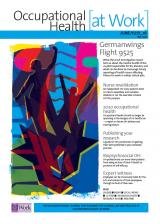June/July 2016 (vol. 13/1)
ContentsFeaturesNewsLegal
NewsResearch DigestResearch PlusCPD
Research Plus
Impact of multisite pain on work ability
Multisite musculoskeletal pain (MMP) – defined as pain in two or more of the following sites: neck and shoulders; low back; upper extremities; and lower extremities – is often associated with poor work ability (WA). But this is not always the case, as this Finnish population-based study revealed. Various modifiable health, work and lifestyle factors were found to mitigate the effects of MMP on WA. Of 3,884 employees aged 30 to 64 in the study, 1,351 reported MMP. WA was assessed on a scale of 0 (worst) to 10 (best), with good WA defined as a score of nine or 10. Nearly half (48%) of women and 37% of men with MMP reported good WA. Among those with MMP, good WA was associated with younger age and female gender. After adjusting for these, good WA was associated with: non-strenuous work (prevalence rate ratio (PRR) = 1.4; CI 1.2–1.6); low job strain (PRR = 1.5; CI 1.3–1.8); high supervisor support (PRR = 1.4; CI 1.2–1.6); high co-worker support (PRR = 1.3; CI 1.2–1.5); absence of musculoskeletal disease (PRR = 1.3; CI 1.2– 1.5), absence of mental disorder (PRR = 1.5; CI 1.2–2.0); no daytime tiredness (PRR = 1.7; CI 1.5–1.9); no money worries (1.3; CI 1.2–1.5); and low alcohol consumption (PRR = 1.2; CI 1.1–1.4).
Scandinavian Journal of Public Health 2016; 44(3): 300–310. doi: 10.1177/1403494815617087.
Occupational Health at Work June/July 2016 (vol. 13/1) pp41



